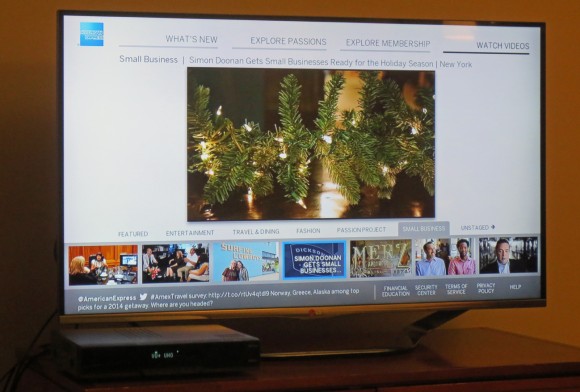
TV service providers have had a monopoly on the consumer television experience for years, but the CE guys finally have a chance to get in on the game. From LG’s launch of WebOS TVs to the incorporation of the Roku platform in TCL and Hisense sets, CES is full of news about how the TV companies are banking on delivering better software to differentiate themselves.
As Dave alluded to, however, it’s hard to imagine that consumers are going to pay too much attention to software when they buy a TV. Worse, the messy ecosystem means it will take longer for any useful new applications and features to gain traction. How are content companies and developers going to deal with creating TV apps for a thousand different connected TVs, set-tops, and streaming sticks?
The one interesting solution out there right now is ActiveVideo’s CloudTV distribution platform. I saw a demo last night of the company’s new AdCast advertising solution, and the technology renders any HTML5 app as a video stream that can be delivered to any connected device. It’s the same concept the company has already shown with UI virtualization. Dave in fact first saw a TiVo UI rendered on a Roku back in June.
By extending to ads and apps, however, ActiveVideo opens new doors for content companies who want to develop new channels and “experiences” that can be seen on any TV. Sure, the first stuff coming out is going to be ads and branded content (as seen above), but the model means companies could put virtually anything on your TV, just the same way they do on the web.
As a consumer, I say forget the TV OS. If this whole virtualization thing works out, we won’t have to worry about what platform our TVs run. Instead, we can continue to pick whatever TV has the best display. And then sit back and enjoy the show.
“As a consumer, I say forget the TV OS.”
I officially declare you persona non grata at CES 2014.
(Plus, I really want a camera and microphone attached to my internet-connected teevee. With retina and voice recognition it’ll be win-win, right?)
Panasonic Teams Up With Mozilla For Firefox OS-Powered Smart TVs & Open Standards Push
“Mozilla and Panasonic will work together to promote Firefox OS and its open ecosystem,” the pair said in a press release today. ”This development aims to deliver more expansive access into smart TVs by leveraging the HTML5 and Web technologies already prevalent on PCs, smartphones and tablets, to offer consumers more personalized and optimized access to Web and broadcasting content and Web services.”
http://techcrunch.com/2014/01/06/panasonic-ffos-tvs/
Haven’t you heard? “Cloud” is now a bad word. This is just another mechanism for the NSA to spy on your life. Perhaps you watch the Al Jazeera network a little too often. Or you simply don’t watch enough TV, which suggests you might be a “free” thinker.
But anyway… I guess the obvious questions for something like this are the usual ones:
– Are any service providers talking about deploying it?
– What kind of latency/response time can we expect (a la OnLive et al) when this is deployed at scale?
I’ll stick with my local boxes for now thanks.
Oh, and I don’t think ANY of the announced updates to the TV OS platforms, neither the Roku, nor the LG, are any threat whatsoever to the cable companies. That continues to come from the little boxes hooked up to TVs, the increasing viability of OTA, the use of laptops to replace TVs, and the rise of mobile.